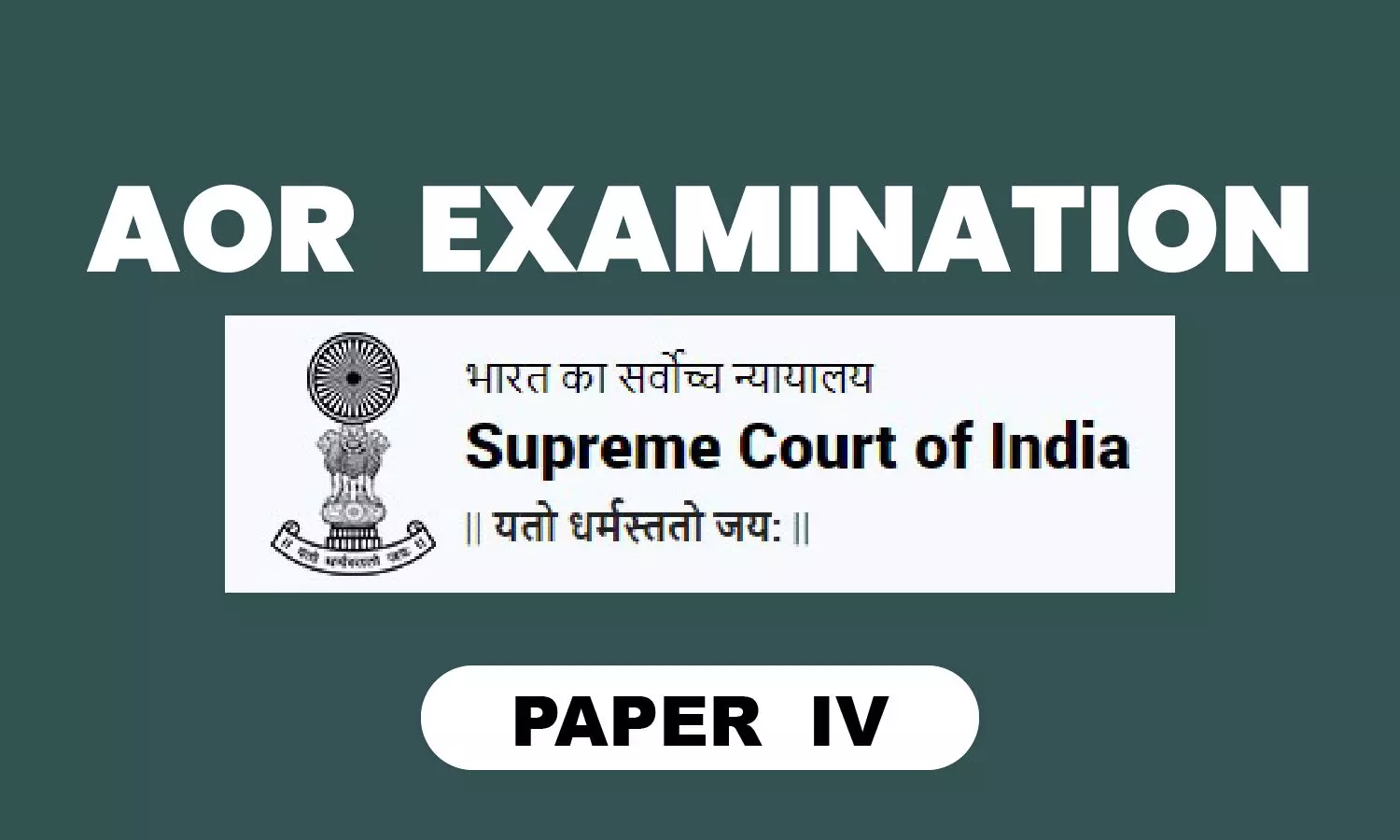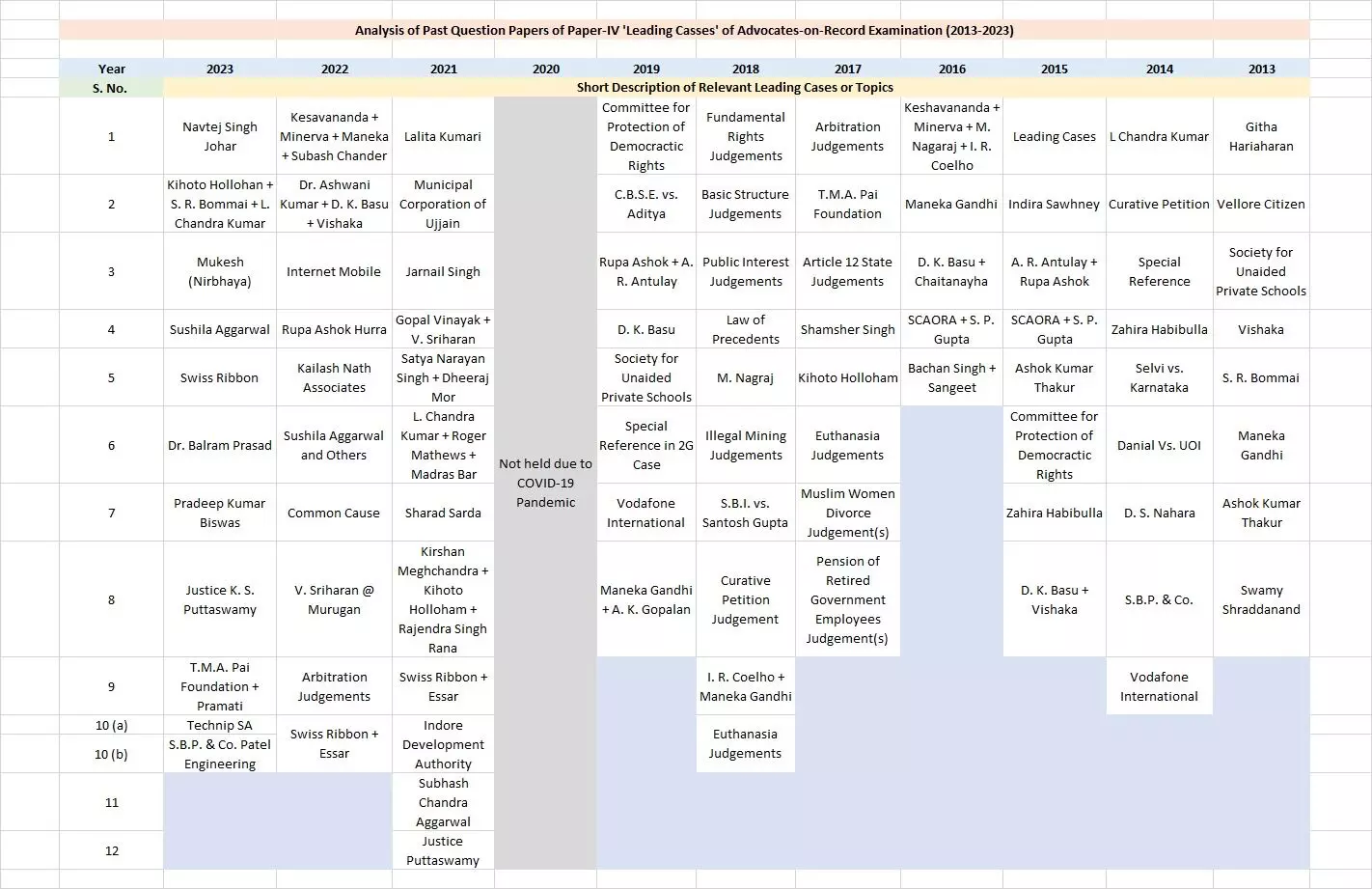
Topper’s Answer Script, Sample Handwritten Note And Guide Points On Paper IV ‘Leading Cases’ Before Attempting The Advocates-On-Record Examination, 2024
 |
|With preparations being carried out in full swing for the Advocates-on-Record Examination 2024 which is scheduled to be held on the 10th, 11th, 14th and 15th of June, 2024 in the Judges’ Library at Additional Building Complex, Supreme Court of India, I, having secured second (2nd) rank in the Advocates-on-Record Examination in the year 2023, find myself better equipped to assist the candidates in some manner, and in that direction and earnest, without disturbing the preparation or any way projecting a different outlook towards the examinations as such, have decided to share the certified copy of my answer scripts and my handwritten notes, besides sharing some guide points having been so gathered through the experience last year. Since I took the voluminous subject i.e., Paper-IV ‘Leading Cases’, first for understanding and preparation, I am sharing the material as well as the guide points in respect of the said paper first, and are as follows:

Lectures by Ld. Senior Advocates organized by the Hon’ble Supreme Court of India.
The Lecture, as delivered by the learned senior advocates, are significant in the manner that one gets the idea as to how the examination has to be attempted. Unlike previous attempts, wherein certain indications made were found to be quite obvious, including the ‘Broad Categorization of Leading Cases’ provided by Sh. Jay Savla, Ld. Senior Advocate; however, except there being four (4) learned senior advocates dealing sixteen (16) cases individually, have given the following inputs:
- The answer should reflect the facts and background while dealing with previous connecting judgements.
- The answer should be clear and crisp.
- The answer should be in one’s own language.
- The citation of the case is necessary.
- The addition of judgements beyond the sixty-four (64) leading cases is optional, but welcoming, especially the Delhi Metro Rail Corporation Ltd. v. Delhi Airport Metro Express (P) Ltd. 2024 SCC OnLine SC 522.
- The cases have to be read and understood broadly.
- The minority view must be studied and tried to be incorporated.
- The answer should reflect as to how the case arose and what the important follow-up was i.e. some judgements/law which was taken after that.
The AoR Exam lecture on Paper IV by Senior Advocate Krishnan Venugopal can be watched here and the lecture by Senior Advocate Aruneshwar Gupta can be watched here.
Analysis of Past Years’ Question Papers of Advocates-on-Record Examination.
The analysis of past years’ question papers may not be found relevant to many, but it does give an essential take about the pattern, at least, to the number of questions being asked and the choice provided therein. Although, the pattern as extracted from the last three (3) years’ papers do give an impression that more variety and complexity is tried to be put so as to cover the maximum number of judgements, the pattern can never be assumed to follow the same in the next attempt. Barring the year 2021 wherein two (2) sub-parts in one (1) question each valuing for ten (ten) marks, nothing of such sort has been found in the last decade, and mostly, twenty (20) marks questions are usually found in the paper. The judgements which are to be focused more, depends on the directions and indications given in the lectures delivered, coupled with self-analysis undertaken, and keeping in mind that judgements asked for or referred to in some questions of certain past years’ may not hold any importance in the current examination, regarding being had to the list of leading case laws applicable now.
Perusal of Topper’s Answer Script in correlation with the Last Year Question Paper.
The perusal of the topper’s answer script when studied along with each question asked would bring the importance of following points of general consideration:
- Margins being drawn on each page.
- Pointers, Flow-Diagrams and Short Paragraphs.
- Restricting Answers between four (4) and six (6) pages.
- Headings and Underlining Key Phrases/Words/Lines.
- Basic Clear Handwriting with Minimal Errors.
- Legal Phrases and Terminologies with Reasonable Drafting Skills.
It is not only significant to point out, but also to be remembered that writing from one’s own mind is much faster than locating, reading and writing from the material provided, ensuring that nothing gets written on the head notes. In the examination hall, where the head notes in hardbound two (2) volumes would be provided, shall have them found placed in a sequence different from the one provided in the notification, and considering the space available on the desk made available there, it would be found extremely difficult to make use of such head notes appropriately. If one is not habitual of using flags, which is unlikely to be the case, then the trouble of locating a particular case law from the head notes volume, in fact the correct volume first, would haunt him or her, which gets really taxing, especially with the kind of questions dealing with more than one (1) case law at once, requiring to put different views from different connected judgements with top-up of minority view as well. The handwriting issue, which obviously scares many, is reasonably based on the expectation that it should be legible, and if not that much legible in whole per se, should appear to be clear and unambiguous. One should not lose sight of the fact that quality matters, and even in case, where one is unable to complete an answer due to any reason including the shortage of time, synopsis be written with appropriate content. It is understandable that minority view cannot be written in every answer, but for some special judgements, one should take note of the same, and in the similar manner, one’s own view point about the judgement, if one is so sure about it, be written at the end, but succinctly. The need to adduce latest or other judgements may be considered an individual choice, and should only be explored if one knows about it, and the same duly complements the answer or is otherwise found required in the context therein. The answers should primarily be a mix of one’s own language and the language used by the Hon’ble Judges in the judgements, and this combination shall largely be based on one’s understanding about the ratio, ratio decided and obiter-dicta of every individual case. The Paper-IV ‘Leading Cases’ takes away most of the time in preparation, and shall never be found enough, has to be dealt with patience and ease, as it can never be said to be difficult nor easy, and therefore, a sample handwritten note is shared as to how one can have his or her notes prepared for last one day innings.
Click here to read/download Author's sample handwritten note
Click here to read/download Author's answer paper
Author is a practicing Advocate-on-Record at the Supreme Court of India, a practicing Advocate and a non-practicing Chartered Accountant. He secured 2nd rank in the Advocates-on-Record Examination in 2023.
[The opinions expressed in this article are those of the author. Verdictum does not assume any responsibility or liability for the contents of the article.]